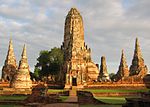This article lists the sites registered with World Heritage in Thailand.
Understand
The Thailand accepts the convention for the protection of the world cultural and natural heritage . The first protected sites were inscribed in 1991.
The Thailand has 5 sites registered with World Heritage, 3 cultural and 2 natural.
The country has also submitted 4 sites to the Tentative List, 3 cultural and 1 natural.
Listing
| Site | Type | Criterion | Description | Drawing | |||||||||||||||||||||
|---|---|---|---|---|---|---|---|---|---|---|---|---|---|---|---|---|---|---|---|---|---|---|---|---|---|
| 1 Ban Chiang Archaeological Site | Cultural | (iii) | Considered the most important prehistoric habitat discovered to date in Southeast Asia, Ban Chiang marked a milestone in the cultural, social and technological evolution of man. The site testifies to the existence of agricultural activities as well as the production and use of metals. |  | |||||||||||||||||||||
| 2 Historic city of Ayutthaya | Cultural | (iii) | Founded around 1350, Ayutthaya became the second Siamese capital after Sukhothai. It was destroyed by the Burmese in the XVIIIe century. Its remains, characterized by prangs, or reliquary towers, and monasteries of gigantic proportions, give an idea of its past splendor. |  | |||||||||||||||||||||
| 3 Historic city of Sukhothai and associated historic towns | Cultural | (i), (iii) | Capital of the first kingdom of Siam in XIIIe and XIVe centuries, Sukhothai preserves admirable monuments illustrating the beginnings of Thai architecture. The great civilization that developed in the kingdom is dependent on many influences and ancient local traditions, but the rapid assimilation of all these elements forged what is called the "Sukhothai style". |  | |||||||||||||||||||||
| 4 Dong Phayayen-Khao Yai Forest Complex | Natural | (x) | The Dong Phayayen-Khao Yai Forest Complex extends over 230 km between Ta Phraya National Park on the Cambodian border in the east, and Khao Yai National Park in the west. The site is home to more than 800 species of fauna, including 112 species of mammals (including two species of gibbons), 392 species of birds, and 200 of reptiles and amphibians. It is of international importance for the conservation of threatened and endangered species of mammals, birds and reptiles on Earth, of which 19 are vulnerable, 4 endangered, and one critically endangered. The area contains critical tropical forest ecosystems, which may provide viable habitat for the long-term survival of these species. |  | |||||||||||||||||||||
| Thung Yai-Huai Kha Khaeng Wildlife Sanctuaries 10 Thung yai 11 Huai Kha Khaeng | Natural | (vii), (ix), (x) | Spanning more than 600 000 Ha Along the border with Myanmar, the shrines, which have remained largely intact, contain almost all of the forest formations of mainland Southeast Asia. They are home to a very diverse set of animal species, including 77% of large mammals (especially elephants and tigers), 50% of large birds and 33% of terrestrial vertebrates found in this region. |  | |||||||||||||||||||||
Criteria legend
| |||||||||||||||||||||||||
